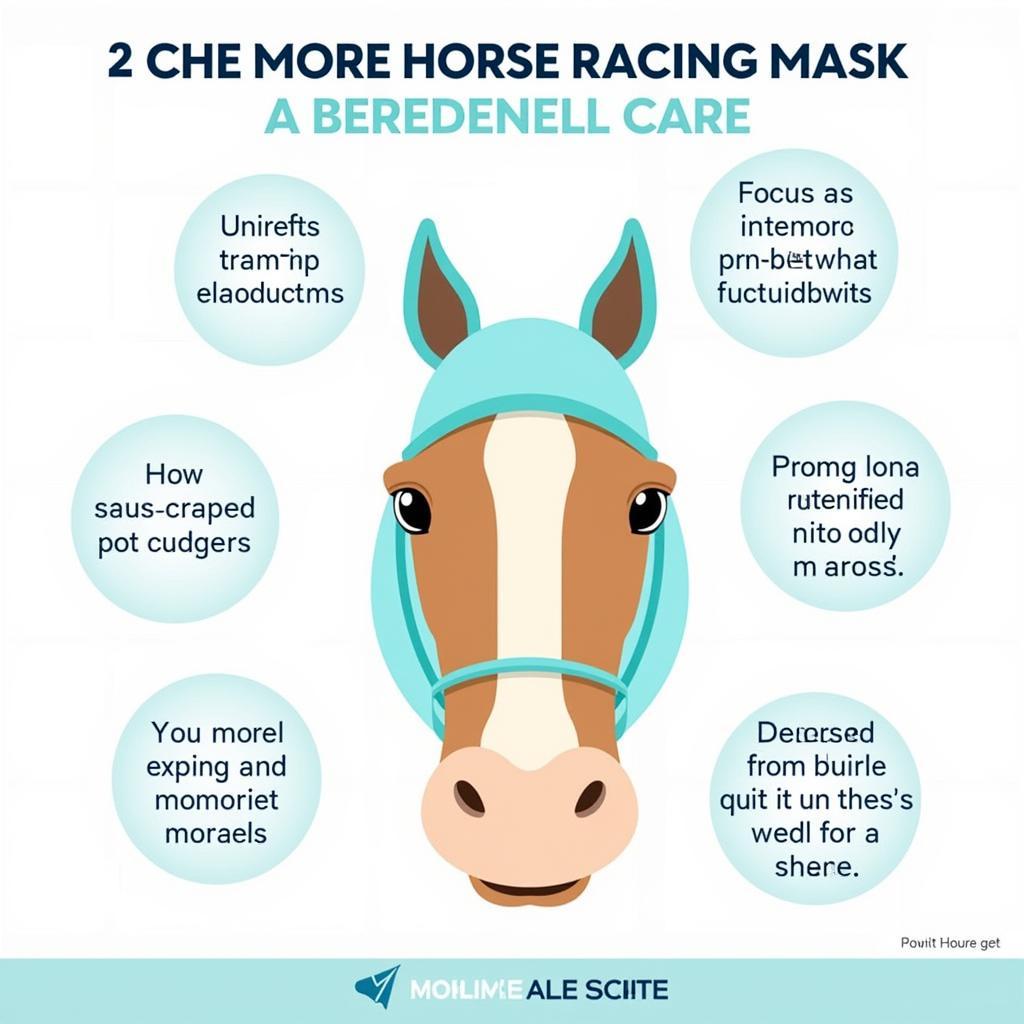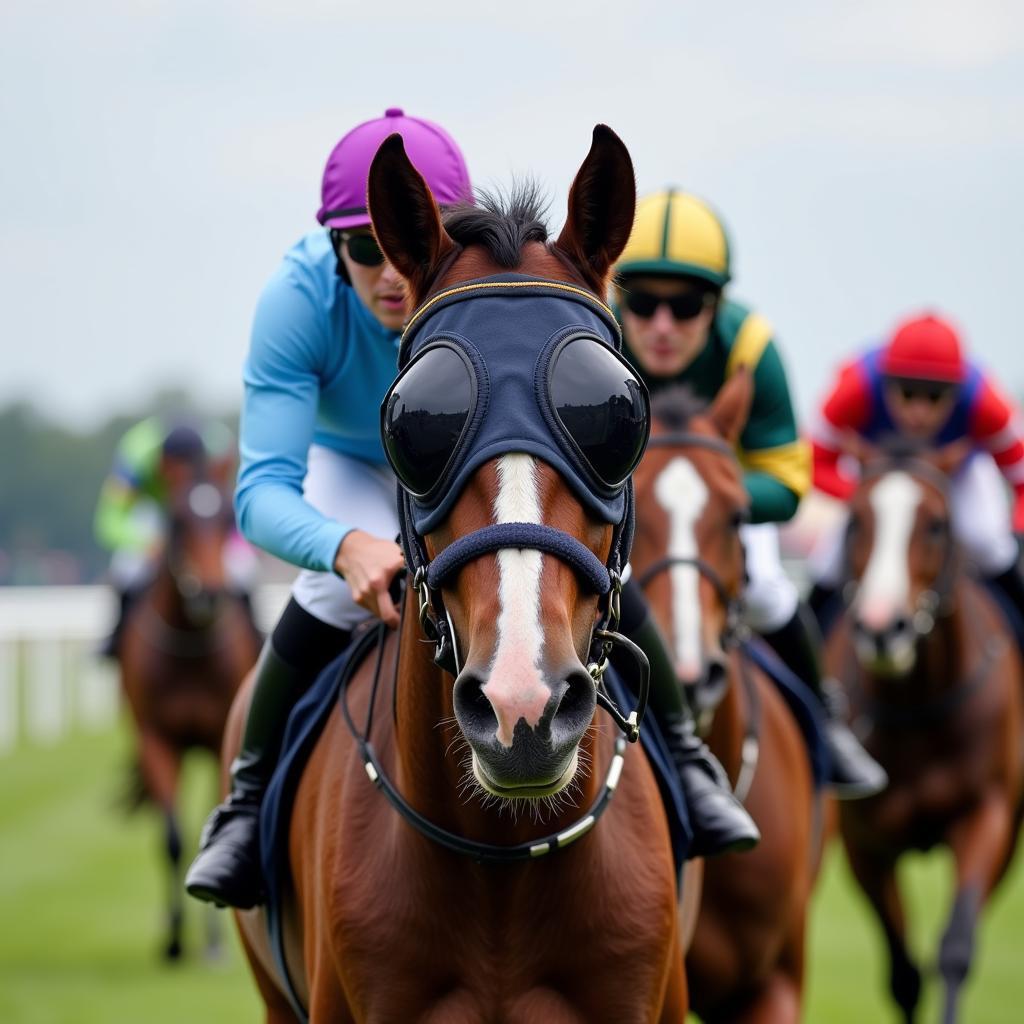Horse Racing Masks are a common sight at racetracks, yet their purpose and importance often go unnoticed by casual observers. These specialized pieces of equipment are much more than just fashion statements; they play a crucial role in a horse’s performance and well-being during races. Let’s delve deeper into the world of horse racing masks and understand their significance.
The Science Behind Horse Racing Masks
 Horse Racing Mask Types
Horse Racing Mask Types
At their core, horse racing masks are designed to manage a horse’s vision and focus during a race. They achieve this by strategically blocking out distractions that could hinder their performance. Imagine running at full speed with a crowd roaring and flags waving – it’s easy to see how a horse could get overwhelmed. That’s where these masks come in.
Different types of masks offer varying levels of visual restriction. Blinkers, for instance, are designed to limit a horse’s peripheral vision, preventing them from getting spooked by other horses or objects in their sideways vision. This allows them to concentrate solely on the track ahead. Cheek pieces, on the other hand, are smaller and mainly prevent a horse from looking backward, ensuring they maintain forward momentum and avoid losing valuable seconds.
More Than Just Vision: The Multifaceted Benefits
 Benefits of Horse Racing Masks
Benefits of Horse Racing Masks
Beyond vision control, horse racing masks offer additional benefits that contribute to a horse’s overall well-being during a race. Some masks, known as shadow rolls, are positioned on the bridge of the nose to minimize shadows cast by the horse’s own head, which could startle them while running. This is particularly beneficial for horses that tend to shy away from shadows or changes in ground texture.
Furthermore, certain masks can help reduce noise distractions, which can be overwhelming for horses, especially in high-stakes races with large crowds. By muffling the noise, these masks contribute to a calmer and more focused demeanor, ultimately enhancing the horse’s performance.
Types of Horse Racing Masks: A Closer Look
 Horse Wearing Blinkers
Horse Wearing Blinkers
Let’s break down the most common types of horse racing masks and their specific uses:
-
Blinkers: These are the most recognizable type, featuring cups positioned on either side of the horse’s head to restrict sideways vision. They come in various sizes and configurations, with larger cups offering more restriction.
-
Cheek Pieces: Smaller than blinkers, cheek pieces are attached to the cheek straps of the bridle and extend alongside the horse’s face. They primarily prevent the horse from looking backward, ensuring they maintain a forward focus.
-
Shadow Rolls: These cylindrical pieces of equipment are placed on the bridge of the horse’s nose to minimize shadows. They can be used independently or in conjunction with blinkers or cheek pieces.
-
Ear Plugs: While not strictly masks, ear plugs are often used in conjunction with other masks to further minimize noise distractions. They are particularly beneficial for horses racing in loud environments.
The Trainer’s Touch: Choosing the Right Mask
The decision of whether or not to use a mask, and what type of mask to use, is made by the horse’s trainer. They carefully consider the horse’s individual temperament, racing style, and any past experiences that might influence their behavior on the track.
For some horses, masks are essential for maintaining focus and preventing distractions. Others may perform better without any visual restrictions. Ultimately, the goal is to find the best approach for each horse to ensure their safety, well-being, and optimal performance.
Beyond the Racetrack: Ethical Considerations
While horse racing masks offer undeniable benefits, their use is not without ethical considerations. Some argue that using masks to restrict a horse’s natural vision is unfair and potentially stressful for the animal. Others believe that masks, when used appropriately, can actually enhance a horse’s well-being by reducing anxiety and distractions.
The debate surrounding the use of horse racing masks highlights the importance of responsible horsemanship and the ongoing need for dialogue about animal welfare within the racing industry. As with any piece of equipment used in equestrian sports, it is crucial that the horse’s welfare remains the top priority.
Looking for More Information on Horse Care?
Interested in learning more about horse care and equestrian sports? Check out our article on horse activities for preschoolers and discover fun ways to introduce young children to the wonderful world of horses!
For those interested in exploring the darker side of horse racing, you can find insightful information in our article on the dark horses crossword clue, where we delve into the intriguing world of hidden contenders and surprise victories.
Need to add a touch of style to your horse’s attire? Look no further! Our article on dress up for horses offers creative ideas and inspiration for making your equine companion stand out from the crowd.
Contact Us Today!
For any questions, concerns, or assistance with your horse care needs, please don’t hesitate to reach out to us. Our dedicated team of equine experts is available 24/7 to provide you with the support and guidance you need. You can contact us via phone at 0772127271, email us at [email protected], or visit us at our location at QGM2+WX2, Vị Trung, Vị Thuỷ, Hậu Giang, Việt Nam.